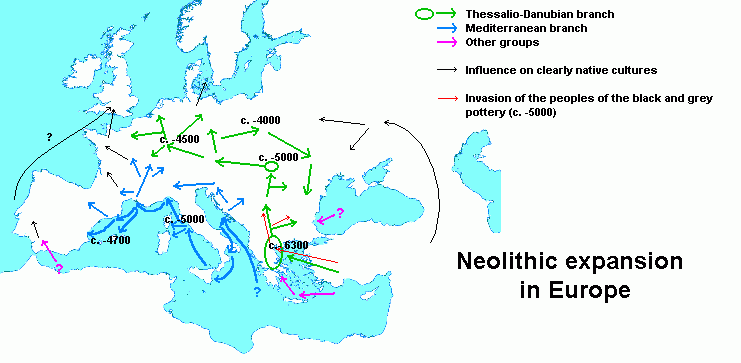By 10,000 BCE the neolithic revolution had already gone well underway amongst a population of mesolithic levantines known as the natufians. These previously forager people began to sow crops such as einkorn, emmerwheat, barley, rye, lentils and as a result this led to an increase in the effective population size which in turn led to the formulation of the Pre Pottery Neolithic culture (PPNA).
By 8,500 BCE this new way of living spread to Anatolia. But was it spread via migration?
The latest studies seem to say no surprisingly. Mesolithic Anatolian samples from Pinarbasi are typically little to no different from later neolithic Anatolian samples from sites such as Boncucklu and Barcin, give or take some very minor natufian and CHG/Iran_N introgression.
 |
| Barcin Hoyuk, Bursa c.6500BC ANF that initially enter SE Europe resemble this population. |
You can read more about this particular study here, it appears that for whatever reason farming developed amongst these Anatolians independent of any foreign influence, or via some sort of 'cultural diffusion' as the "pots not people" crowd would say. It seems this particular population of mesolithic/neolithic Anatolians evolved from a clade separate to that of natufians but rather of upper paleolithic hunter gatherers from the Caucasus mountains (Dzudzuana) according to the recent Lazaridis preprint. (See here)
Then roughly around 6,500 BCE these northwest Anatolian neolithic highlanders push west into the Aegean, introducing agriculture to Europe for the first time in prehistory, bringing their cattle, pots and thicc venus figurines with them.
From there, this migration (or invasion if you're an Anprim) diverges into two differing branches stemming from the Aegean launching point, with one arriving into central Europe around 5,500 BCE forming the LBK (Linearbandkeramik) horizon, and another directly across the Mediterranean forming the Cardial ware culture, also known as 'Impressed Ware' by archaeologists due to the impressions on the ceramic type utilised.
By around 4,000 BCE these farmers finally reach Ireland, characterised by their series of megalithic henges dotted across the island the most famous of which being that of Newgrange in county Meath.
But from which migration path did this new EEF population arise from?
Thankfully we have a high resolution genome available from Ballynahatty in county Antrim available to play around with in order to find out.
| Reconstruction of Ballynahatty woman, her phenotype appears to be that of Gracile Med type, common amongst EEF. |
Reconstruction of a cardial EEF woman from Gibraltar
nicknamed Calpeia who lived around 5,500BC.
Her relatives would eventually repopulate Ireland
over a thousand years later.
To do this I will be modelling her using samples from cardial Iberia for her 'southern' admixture and LBK Germany sample for her central european EEF admixture.
And the results are indeed quite interesting.
She does come out as mostly of cardial stock, which would confirm the findings of the 2015 Trinity college study that analysed her genome showing her to have shared more drift with EEF from Iberia and not central Europe. The closest contemporary population to her being Sardinians, she seemed to have had a relatively swarthy southern european complexion. Although it is plausible that a separate migration from central Europe made it into Ireland, as it is confirmed to have in Britain by the recent Brace et al study from earlier this year. (Yeah you can read about that one here too.)
Until we get more samples from the period we won't know. Although some from Carrowmore and Primrose in county Sligo have been published in this recent study, see here.



No comments:
Post a Comment